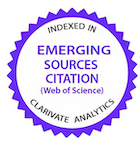Desempenho e morfometria duodenal de frangos de corte submetidos a diferentes níveis de energia e programas de alimentação de 42 a 57 dias de idade
DOI:
https://doi.org/10.5216/cab.v13i2.9781Palavras-chave:
aminoácidos digestíveis, energia metabolizável, morfometria intestinalResumo
O experimento foi realizado com o objetivo de avaliar diferentes níveis de energia e programas de alimentação sobre o desempenho, as características de carcaça e a morfometria da mucosa do duodeno de frangos de corte de 42 a 57 dias de idade. Foram utilizados 1.600 pintos machos “Cobb 500”, em um delineamento inteiramente ao acaso, em esquema fatorial 2X4, sendo dois níveis de energia (3.200 e 3.600 kcal EM/kg) e quatro programas de alimentação. Os níveis energéticos ou os diferentes programas de alimentação não determinaram diferenças expressivas nas características de carcaça que justifiquem a escolha de um nível de energia ou de um programa alimentar, devendo prevalecer o nível energético e as recomendações de aminoácidos que determinem o maior custo-benefício. Observou-se que o nível 3.600 kcal EM/kg proporcionou melhoria no desempenho das aves e na morfometria da mucosa intestinal e o fracionamento das exigências de aminoácidos digestíveis em dois períodos piorou os resultados de desempenho e de altura de vilosidade.
PALAVRAS-CHAVE: Aminoácidos digestíveis; energia metabolizável; exigências nutricionais; intestino delgado.
Downloads
Downloads
Publicado
Como Citar
Edição
Seção
Licença
Copyright (c) 2012 Ciência Animal Brasileira / Brazilian Animal Science

Este trabalho está licenciado sob uma licença Creative Commons Attribution 4.0 International License.
Autores que publicam nesta revista concordam com os seguintes termos:
- Autores mantém os direitos autorais e concedem à revista o direito de primeira publicação, com o trabalho simultaneamente licenciado sob a Licença Creative Commons Attribution que permite o compartilhamento do trabalho com reconhecimento da autoria e publicação inicial nesta revista.
- Autores têm autorização para assumir contratos adicionais separadamente, para distribuição não-exclusiva da versão do trabalho publicada nesta revista (ex.: publicar em repositório institucional ou como capítulo de livro), com reconhecimento de autoria e publicação inicial nesta revista.
- Autores têm permissão e são estimulados a publicar e distribuir seu trabalho online (ex.: em repositórios institucionais ou na sua página pessoal) a qualquer ponto antes ou durante o processo editorial, já que isso pode gerar alterações produtivas, bem como aumentar o impacto e a citação do trabalho publicado (Veja O Efeito do Acesso Livre).






























